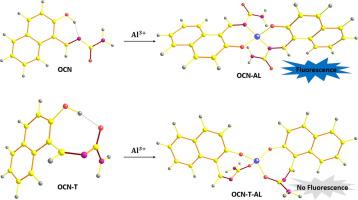Spectrochimica Acta Part A: Molecular and Biomolecular Spectroscopy ( IF 4.3 ) Pub Date : 2022-04-08 , DOI: 10.1016/j.saa.2022.121237 Hongsheng Zhai 1 , Mengyao Zhu 1 , Xueli jia 1 , Yang liu 1 , Tiantian Guan 1 , Yonggang Yang 1 , Yufang Liu 1

|
A new action mechanism for the fluorescent detection on the Al3+ ion of the sensitive 1-((2-hydroxynaphthalen-1-yl)methylene)urea(OCN) is theoretically studied. The extensive theoretical calculations on the OCN and the isomer structure OCN-T are performed. The emission and absorption spectra consistent with the experiment value. The absorption spectra peaks (362 nm and 326 nm) of OCN and OCN-T molecules are attributed to the experimentally observed absorption spectra at 356 nm and 314 nm, respectively. The calculated fluorescence value of the OCN-AL structure is 460 nm, while the OCN-T-AL structure has no fluorescence. These results better explain that OCN and its isomers OCN-T are involved in the absorption, and the detection spectrum signal is emitted from the OCN-AL complex. The OCN and OCN-T molecules are obvious hydrogen bonding systems. The excited state intramolecular proton transfer photochemical behaviors and detecting Al3+ ion photophysical changes were explained for the first time at the molecular level. As driving force of excited state intramolecular proton transfer (ESIPT) reaction, the bond parameters and vibrational frequencies of intramolecular hydrogen bond were analyzed by optimizing structures and calculating infrared spectra, analysis of frontier molecular orbitals. To further elucidate the proton transfer reactive paths, the scanned the potential energy curves (PECs) of OCN and OCN-T chemosensor in different electronic states are plotted. This work proposes a reasonable explanation for the detection mechanism of the OCN sensor.
中文翻译:

Al3+离子传感器1-((2-hydroxynaphthalen-1-yl)methylene)urea(OCN)荧光特性及ESIPT机理的理论研究
Al 3+荧光检测的新作用机制对敏感的1-((2-hydroxynaphthalen-1-yl)methylene)urea(OCN)离子进行了理论研究。对 OCN 和异构体结构 OCN-T 进行了广泛的理论计算。发射光谱和吸收光谱与实验值一致。OCN 和 OCN-T 分子的吸收光谱峰(362 nm 和 326 nm)归因于分别在 356 nm 和 314 nm 处实验观察到的吸收光谱。OCN-AL结构的计算荧光值为460 nm,而OCN-T-AL结构没有荧光。这些结果更好地解释了OCN及其异构体OCN-T参与了吸收,检测光谱信号是从OCN-AL复合物发出的。OCN和OCN-T分子是明显的氢键系统。首次在分子水平上解释了3+离子的光物理变化。作为激发态分子内质子转移(ESIPT)反应的驱动力,通过优化结构、计算红外光谱、分析前沿分子轨道等方法,分析了分子内氢键的键参数和振动频率。为了进一步阐明质子转移反应路径,绘制了OCN和OCN-T化学传感器在不同电子状态下的扫描势能曲线(PEC)。这项工作为OCN传感器的检测机制提出了合理的解释。






























 京公网安备 11010802027423号
京公网安备 11010802027423号